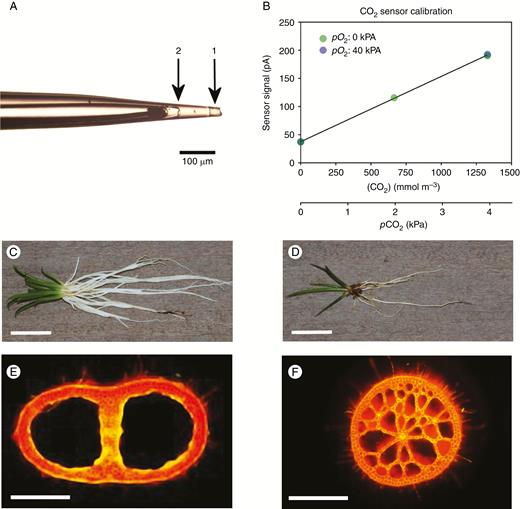-
You are viewing the forum as a Guest, please login (you can use your Facebook, Twitter, Google or Microsoft account to login) or register using this link: Log in or Sign Up
You are using an out of date browser. It may not display this or other websites correctly.
You should upgrade or use an alternative browser.
You should upgrade or use an alternative browser.
Aquatic CAM plants question
- Thread starter Nont
- Start date
-
- Tags
- aquatic plants co2
Crassulacean acid metabolism (CAM) has mostly been studied in xerophytic plants. In these plants it's an adaptation to arid conditions, allowing the plant to photosynthesise during the day and exchange gases at night with minimal water loss. In aquatic plants the mechanism allows CO2 uptake at night when it is most abundant.
It would be an advantage to continue CO2 injection through the night if aquatic CAM species were exclusively limited to nocturnal CO2 uptake, but I doubt they are. As an aside, folk who inject CO2 24/7 regardless, have apparently observed better and healthier plant growth in species not known to utilise CAM. Either way, you could give it a go and see for yourself. But you'll need ensure the tank water remains well oxygenated at night.

 en.wikipedia.org
en.wikipedia.org
It would be an advantage to continue CO2 injection through the night if aquatic CAM species were exclusively limited to nocturnal CO2 uptake, but I doubt they are. As an aside, folk who inject CO2 24/7 regardless, have apparently observed better and healthier plant growth in species not known to utilise CAM. Either way, you could give it a go and see for yourself. But you'll need ensure the tank water remains well oxygenated at night.
Crassulacean acid metabolism - Wikipedia
John q
Member
The scientific evidence would agree with you Tim.It would be an advantage to use CO2 at night if aquatic CAM species were exclusively limited to nocturnal CO2 uptake, but I doubt they are.
Quote.
"Furthermore, daytime inorganic carbon uptake is generally not inhibited and therefore CAM is considered to be a carbon-conserving mechanism. CAM in aquatic plants is a plastic mechanism regulated by environmental variables and is generally downregulated when inorganic carbon does not limit photosynthesis. "

Crassulacean acid metabolism in the context of other carbon-concentrating mechanisms in freshwater plants: a review - Photosynthesis Research
Inorganic carbon can be in short supply in freshwater relative to that needed by freshwater plants for photosynthesis because of a large external transport limitation coupled with frequent depleted concentrations of CO2 and elevated concentrations of O2. Freshwater plants have evolved a host of...
Also found this.
Comparison of rates of underwater photosynthesis (PN) in the C3 and CAM isoetids
The benefit of CAM in Littorella uniflora was evident in the data on underwater PN. Leaf tissues of L. uniflora sampled at the end of the dark period showed significantly higher rates of PN compared with leaves from the C3 plant but only when external CO2 supply was low and limiting (Fig. 4C); high external CO2 masked the benefit of CAM (Fig. 4D). This finding confirms previous studies of L. uniflora and other aquatic CAM plants that strongly indicate that CAM is of benefit only when environmental CO2 is scarce (Madsen, 1987; Keeley, 1998; Klavsen and Madsen, 2012).
CO2 and O2 dynamics in leaves of aquatic plants with C3 or CAM photosynthesis – application of a novel CO2 microsensor
AbstractBackground and Aims. Leaf tissue CO2 partial pressure (pCO2) shows contrasting dynamics over a diurnal cycle in C3 and Crassulacean Acid Metabolism
Last edited:
Thanks for the answer Tim and John, I’ll have a read through the link.
I have one more question; speaking about the global warming, I would like to know how many % of CO2 has been release out of the tank during both day and night time?
I have one more question; speaking about the global warming, I would like to know how many % of CO2 has been release out of the tank during both day and night time?
John q
Member
Ball Park figure 90 to 95 %Thanks for the answer Tim and John, I’ll have a read through the link.
I have one more question; speaking about the global warming, I would like to know how many % of CO2 has been release out of the tank during both day and night time?
Goodness gracious! I might have to manually close my citric acid CO2 then…Ball Park figure 90 to 95 %
I'm not sure how the bicarbonate used in the reaction is created, but if you are really worried about this, you could switch to sugar and yeast. Sugar comes from plants, which absorb their carbon from the atmosphere, therefore forming a closed carbon cycle where you release CO2 to the atmosphere, the plants absorb it and create sugar. There are, of course, CO2 "losses" with transportation and production processes, like heating.Goodness gracious! I might have to manually close my citric acid CO2 then…
Guys relax and enjoy the hobby guilt free, it's a force for good in a world gone insane. CO2 from planted tanks isn't going to cause an existential global crisis or contribute to one: even if the worst case apocalyptical claims about anthropogenic climate change are true, which I very much doubt 
Wookii
Member
Also when you appreciate that the average human breathes out around 1kg of CO2 each day, it puts in context the relatively tiny amount we use in the average CO2 injected tank where a kilo of CO2 lasts several weeks or months.


